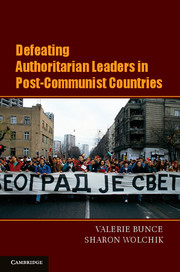Book contents
- Frontmatter
- Contents
- List of Figures and Tables
- Acknowledgments
- PART I THE PUZZLE
- PART II CASE STUDIES
- 3 The 1998 Elections in Slovakia and the 2000 Elections in Croatia
- 4 Defeating a Dictator at the Polls and in the Streets
- 5 Ukraine
- 6 Georgia and Kyrgyzstan
- 7 Failed Cases
- PART III COMPARATIVE ANALYSES
- Appendix
- Index
3 - The 1998 Elections in Slovakia and the 2000 Elections in Croatia
The Model Solidifies and Is Transferred
Published online by Cambridge University Press: 05 June 2012
- Frontmatter
- Contents
- List of Figures and Tables
- Acknowledgments
- PART I THE PUZZLE
- PART II CASE STUDIES
- 3 The 1998 Elections in Slovakia and the 2000 Elections in Croatia
- 4 Defeating a Dictator at the Polls and in the Streets
- 5 Ukraine
- 6 Georgia and Kyrgyzstan
- 7 Failed Cases
- PART III COMPARATIVE ANALYSES
- Appendix
- Index
Summary
I Vote, Therefore I Am
Civic Campaign poster, Slovakia, 1998I want to live in a normal country.
Croatia, 2000This chapter and the four that follow set the empirical stage for analyzing why elections in mixed regimes in postcommunist Europe and Eurasia have had such different effects. In this chapter we focus on the 1998 elections in Slovakia and the 2000 elections in Croatia, which were the beginning of the wave of electoral turnovers in the postcommunist world. In contrast to the cases we analyze in later chapters in this section, these elections were largely free and fair, and electoral mobilization was sufficient, as a result, to bring about a transition from semi-authoritarian rule to rule by the democratic opposition. We devote particular attention to the Slovak case, as it was in Slovakia that the set of innovative electoral strategies, tactics, and tools – which we have termed the electoral model of regime change – was first elaborated fully in the postcommunist world. Once these proved successful, the Slovak case was quite influential in the electoral confrontations that followed the Slovak precedent – not just in Croatia in 1999–2000, but also in Serbia, Georgia, Ukraine, Kyrgyzstan, and even in Armenia, Azerbaijan, and Belarus. Because elements of the strategies and tactics that proved successful in Slovakia and later in Croatia were present in the 1996 elections in Romania, and because the protests and elections in Bulgaria in 1996–97 had a large influence on the strategies and tactics later elaborated in Slovakia, we begin this chapter with a discussion of those events.
- Type
- Chapter
- Information
- Publisher: Cambridge University PressPrint publication year: 2011
- 3
- Cited by



